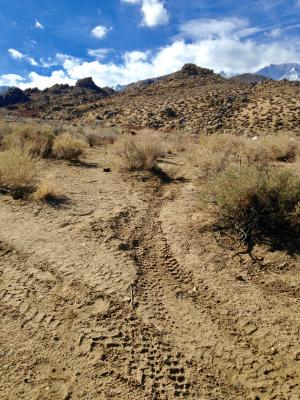
Inyo County began this project by asking for an easement or a 5-year conditional use permit for 8 segments of roads that are in the USFS. These are all existing roads that are maintained by Inyo County. This transfer would allow the County to expand the Adventure Trails Pilot Program to include routes that would include these segments. ROLG, FOI, CBD, SNBS Foundation and School of Lost Borders submitted comment letters along with many individuals asking for an environmental report, expressing concerns for the proposal, or opposing it.
In May 2020 Inyo County amended their request asking for just 4 road easements instead of 8 and are now saying the easements are needed for road maintenance. It is true that the county has been maintaining these USFS roads and many others without a Memorandum of Understanding between the county and the Forest Service. However, that is not what this request is really about.
By having the project be just about easements and not road use designations, the USFS would not do the same level of analysis of the environmental impacts. If Inyo County wants to change the road usage after obtaining the easements, it would also need to prepare an environmental review under the California Environmental Quality Act (CEQA). The difference between the USFS vs. Inyo County doing an environmental review is the scope and depth of the environmental review.
Inyo County was the CEQA lead for the Adventure Trails Program (A-T) and it narrowed the scope of the Environmental Impact Report (EIR) to consider only environmental impacts on the road itself, i.e. the road and the shoulders. That narrow view failed to identify and address impacts to the adjacent public lands and natural resources where significant environmental damage would be i.e. beyond the trailheads and the land beside the road. That is why the Center for Biological Diversity and Public Employees for Environmental Responsibility sued the County for an inadequate EIR.
After combing through documents received through a Freedom of Information Act request, it is clear that the actual goal of the easement request is to expand the Adventure Trails Program and not to facilitate road maintenance. By breaking the project up into two steps: 1) obtain easements first and then 2) make the change to allow OHVs on them, the County can narrow the scope of the environmental review once again to look at just impacts to the roads and their shoulders. Where the USFS would consider the broader impacts to public lands as part of the decision whether or not to allow OHVs, the County won’t.
The USFS would be creating an enforcement and maintenance nightmare for itself if they grant Inyo County these easements. Inyo County will market the Adventure Trails Program. Imagine 500,000 OHVs coming to Inyo County annually instead of 50,000 (per 2015 Inyo NF survey). Kern County OHV riding areas attract over 800,000 OHV visitors a year. Just with the current level of OHV activity a local Inyo citizen’s group has documented 80 instances of trespass and damage over the last 6 months.
While the A-T Program is a popular idea for some, it is controversial due to its potential for damage to our natural resources, illegal trespass, incursions into wilderness, conflicts with other types of recreation, and the added burden of increased number of visitors, vegetation repair, and law enforcement on the USFS, BLM, and NPS. We need to take a hard look at those impacts before deciding what is best for the public. A decision by the USFS is expected November 2020.